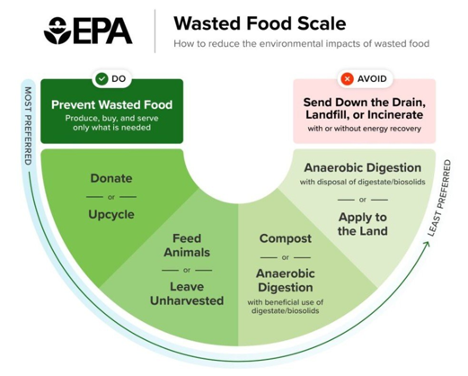
Educating Rising Culinarians about Food Donation
05 November 2024A comprehensive lesson plan focusing on discussing and comprehending food waste and how it can be curbed through donation.
By Dr. Jonathan Deutsch, Drexel University
and Anya Obrez, Natural Resources Defense Council
Feedback & comments: This email address is being protected from spambots. You need JavaScript enabled to view it.
Up to 40% of food in the US is lost or wasted, all along the supply chain from crops left in the field due to lack of labor or low market prices, to retail products that remain unsold at their sell-by date, to plate waste or overproduction from large restaurant portions. At the same time, about one in eight Americans experience food insecurity and hunger. Much of the food that goes to waste is perfectly suitable for donation to people experiencing this food insecurity. So why is food not being donated?
While there are a variety of reasons including transportation costs, availability of cold storage, and logistics, one of the leading reasons that more excess and nutritious food isn’t donated—and a totally preventable one—is the lack of awareness about liability protections for individuals donating food products. A prevalent misconception in this country, about 50% of food manufacturers and 25% of food retailers, including restaurateurs, believe that liability prevents them from being able to donate food.
Since 1996, the Bill Emerson Good Samaritan Food Donation Act has provided liability protection for food donors. That law was further strengthened with the 2022 bipartisan Food Donation Improvement Act. In the October Gold Medal Classroom issue we wrote, “The Food Donation Improvement Act: A Guide for Culinary Educators.” To accompany the article, we created this lesson plan which will show how this important legislation can be introduced to culinary and hospitality students, both secondary and postsecondary levels, as well as provide additional resources.
Set induction: discussion or free write
Think about one commonly wasted food in your kitchen. If you work in the food industry, it can be your work kitchen. If not, think about your culinary classroom or your home kitchen. Is it soured milk, delicate herbs that go unused or overproduced rice or mashed potatoes? Is it uneaten portions that go back to the dish station at a restaurant? Choose one of these foods and write about why it is wasted.
Lecture and video: overview of the problem of food waste and the food recovery scale
PowerPoint Presentation: Introducing the Food Donation Improvement Act
Discussion: applying this information
Display or handout slide 16 of the PowerPoint - Wasted Food Scale.

© EPA, October 2023
Go back to the food you wrote about or discussed at the beginning of the lesson. Indicate where on the Wasted Food Scale you would find that food. Is this good? What could be done to move it further to the left on the scale? What strategies could you implement to minimize its waste and promote better usage?
Comprehension activity: Can be done in class, in groups, or as pre- or post-lesson homework.
Consider the PPT presentation and read the legal fact sheet, “Federal Liability Protection for Food Donation.” Answer the following questions:
- In your own words, what does “immunity from liability related to food donations” mean?
- How many years have businesses in the US had liability protections when donating food?
- How many court cases are related to food donation liability?
- Would a school culinary program be covered under the Emerson Act? How about a restaurant? Indicate where on the fact sheet you found that information.
- List and explain in your own words the four conditions required to receive liability protections under the Emerson Act.
- A chef donates visibly moldy strawberries. Which condition of the Emerson Act would not be satisfied?
- A school receives a donation of day-old pastries from a supermarket and sells them as a bake sale fundraiser. Which condition of the Emerson Act would not be satisfied?
Another comprehension activity that could be a discussion question or critical thinking essay:
The Bill Emerson Good Samaritan Food Donation Act was passed in 1996, longer than most culinary students have been alive. Why do you think many chefs and restaurant managers still think they can’t donate food due to liability? Is this misunderstanding a problem? Why or why not? If so, how would you solve this problem?
Application
Choose your own culinary program or a restaurant/foodservice operation selected by your instructor as a case study. Analyze food products that are typically wasted. Using the Wasted Food Scale, choose 3-5 commonly wasted foods and develop a plan for how they could be moved further left on the Wasted Food Scale to be prevented, donated or upcycled. If they cannot be, explain what is preventing them from being able to be prevented, donated or upcycled.
**********************************************************************************
Editor’s Note: Read, “Recovering Food Waste: How an Action Plan Came to Fruition. CIA’s Robert Perillo shares his journey planning and implementing a food waste program that donated over 121,000 pounds of food since its inception” for a case study in creating a food waste reduction program.
Also, please read, “The Food Donation Improvement Act: A Guide for Culinary Educators. New act expands liability protections for food donors and encourages food businesses – including schools and non-profit organizations – to donate” for more information.
